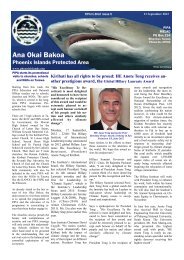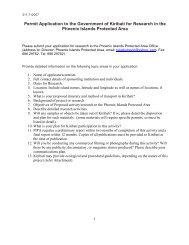Nomination for a World Heritage Site 2009 - Phoenix Islands ...
Nomination for a World Heritage Site 2009 - Phoenix Islands ...
Nomination for a World Heritage Site 2009 - Phoenix Islands ...
You also want an ePaper? Increase the reach of your titles
YUMPU automatically turns print PDFs into web optimized ePapers that Google loves.
shore fishes. Allen (in press) estimated that approximately 19 percent of the overall Pacific<br />
Plate fauna is endemic, based on an analysis of 17 common reef fish families.<br />
The endemicity of reef fish is largely unknown. The recently described damselfish<br />
(Chrysiptera albata) and goby (Trimma squamicanta) are currently known only from the<br />
<strong>Phoenix</strong> <strong>Islands</strong>. However, they can be expected at other areas in the central Pacific such as<br />
the Line <strong>Islands</strong>.<br />
<strong>Phoenix</strong> <strong>Islands</strong> fishes with apparent restricted distributions:<br />
Species General Distribution<br />
Myripristis earlei (Holocentridae) Marquesas and <strong>Phoenix</strong> <strong>Islands</strong><br />
Paracirrhitus nisus (Cirrhitidae) Tuamotus and <strong>Phoenix</strong> <strong>Islands</strong><br />
Kuhlia petit (Kuhliidae) Marquesas and Phoneix <strong>Islands</strong><br />
Chaetodon declivis (Chaetodontidae) Marquesas, Line Is., and <strong>Phoenix</strong> Is.<br />
Apolemichthys xanthopunctatus (Pomacanthidae) Gilbert, <strong>Phoenix</strong>, and Line <strong>Islands</strong><br />
Chrysiptera albata (Pomacentridae) Nikumaroro Atoll<br />
Bodianus prognathus (Labridae) Line and <strong>Phoenix</strong> <strong>Islands</strong><br />
Coris centralis (Labridae) Line and <strong>Phoenix</strong> <strong>Islands</strong><br />
Parapercis lata (Pinguipedidae) Line and <strong>Phoenix</strong> <strong>Islands</strong><br />
Ctenogobiops sp. (Gobiidae) Line and <strong>Phoenix</strong> <strong>Islands</strong><br />
Priolepis ailina (Gobiidae) Society and <strong>Phoenix</strong> <strong>Islands</strong><br />
Trimma squamicana (Gobiidae) <strong>Phoenix</strong> <strong>Islands</strong><br />
Inter-island comparisons:<br />
Although general diving conditions of the various islands are similar due to the relatively<br />
homogenous atoll environment, each island possesses distinctive faunal characteristics.<br />
Below some of the most obvious fish faunal highlights or peculiarities of each island are<br />
mentioned (from Allen and Bailey).<br />
Nikumaroro Atoll. – Huge numbers of surgeonfishes were one of the most impressive faunal<br />
features of the <strong>Phoenix</strong> <strong>Islands</strong> in general and some of the largest aggregations were<br />
witnessed here. Schooling species included Acanthurus triostegus, A. guttatus, A. nigroris, A.<br />
xanthopterus, and Zebrasoma veliferum. Nikumaroro was also the best location <strong>for</strong> sharks,<br />
including Charcharhinus amblyrhynchos, C. melanopterus, and Triaenodon obesus. As many<br />
as 15-20 sharks were seen on each dive. Other highlights included large schools of Lutjanus<br />
fulvus and an inordinate number of hawkfishes, which were generally abundant throughout<br />
the <strong>Phoenix</strong> Group.<br />
Manra Island. – Manra was notable <strong>for</strong> its abundance of the surgeonfish Acanthurus guttatus,<br />
which <strong>for</strong>med large feeding shoals in shallow, wave-affected gutters. In addition, an<br />
extensive sand patch at dive site 18 yielded about 20 individuals of Malacanthus brevirostris<br />
as well as numerous Coris centralis. Other extraordinarily abundant fishes included Kyphosus<br />
cinerascens and Mulloidichthys mimicus.<br />
Rawaki Island. – Plectognaths (triggerfishes, puffers, and allies) were generally abundant.<br />
The most puffers (Arothron meleagris) were seen at this island, including up to 15-20 fish in<br />
a single aggregation. There was also an abundance of the relatively rare Xanthichthys<br />
triggerfishes (X. auromarginatus and X. caeruleolineatus).<br />
41





